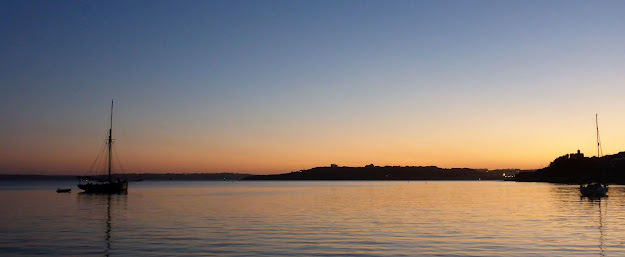As ever, we've had an eye on the long-term forecasts and spotted that, after days of very light breezes, brisk easterlies were on the cards at the end of this week, just when we were planning to sail east, back to Dartmouth. We therefore revised our plans and decided to leave Falmouth on Sunday, with a couple of stops en route. First, though, we needed some provisions so we took the dinghy, powered by its wonderful electric outboard, up the Truro River to Tesco!
 |
| Following the marked channel between the the mud banks in the final approach to Truro. You can only make this trip at high tide and then only in a shallow-draft boat |
 |
| The last time we did this trip was in one of these - a Parker 235 lift-keel trailer-sailer. Gentoo was our only brand-new boat and we loved exploring shallow waters and did some epic cruises in her. |
 |
| Shopping-by-dinghy completed, we headed back downstream before the tide dropped, pursued by a keen young kayaker |
We returned to Maunie having used pretty much all of the outboard's lithium battery capacity - it reckoned we had 6 minutes of motoring left but that wasn't bad after nearly 6 miles.
We fitted in a mid afternoon drink with Simon and Kerry at the Pandora Inn, having moved back to our borrowed mooring.
The departure from Falmouth on Sunday began in very light airs but in rather elegant company:

 |
Note the crewman climbing the mast, for scale
|
 |
| St Antony's Head lighthouse, which guards the eastern side of the Fal entrance. The lobster pot buoy in the foreground was one of many in this area - a real risk to navigation for the unwary! |
Our 8-hour, 60 nm passage involved motor-sailing all of the way in a breeze that never increased more than 7 knots but at least the sails added about half a knot to our progress and the water was absolutely calm. We arrived at the entrance to the River Yealm to find the anchorage absolutely full of boats but, as we hoped, all but five of them returned to Plymouth as the evening light faded so we had uninterrupted views of the sunset.
The easterly breeze began to build in the morning so we had a lovely beat to our next anchorage, Hope Cove. It would be 12 miles by motorboat but tacking against the wind saw us cover 20 miles until we dropped anchor in a place that, to be honest, we'd normally avoid. Hope Cove was presumably named by sailors who prayed that it would be a safe anchorage when in reality it was a terrible death-trap for sailing ships driven on to the rocks by the prevailing south-westerlies. However with our easterly wind and calm seas it was a lovely overnight stop.
 |
It's not a pretty village but at least the new extension to the hotel, with its hideous orange roof, means that there's no mistaking the cove as you approach from seaward
|
 |
There's no harbour to speak of, but the seawall offers some protection to the drying beach
|
 |
Maunie's the middle yacht, lying to the very gentle easterly breeze
|
We were particularly pleased to stop here because Di's sister Sue and her husband Mark were staying in a Hope Cove holiday cottage with their daughter Amy and her husband Joe. Amy was a very keen crew aboard several of our boats, starting when she was only about 9 years old, and it was wonderful to meet Benjamin, our great-nephew of 7 months.
The final leg of our cruise was another calm-water motor around Start Point with just enough breeze to sail the last couple of miles and about 2 knots of tide pushing us towards our destination . Safely back on our mooring with a few boat jobs to do, we look back on this little trip as being one of the most relaxing UK cruises we've ever done - no huge mileages or overnight passages, no reefs put into sails or hatches battened down. Just a chance, in all the doom and gloom of COVID, to enjoy the delights of this wonderful coastline and to see people that we might not be able to see again for a while.



















































